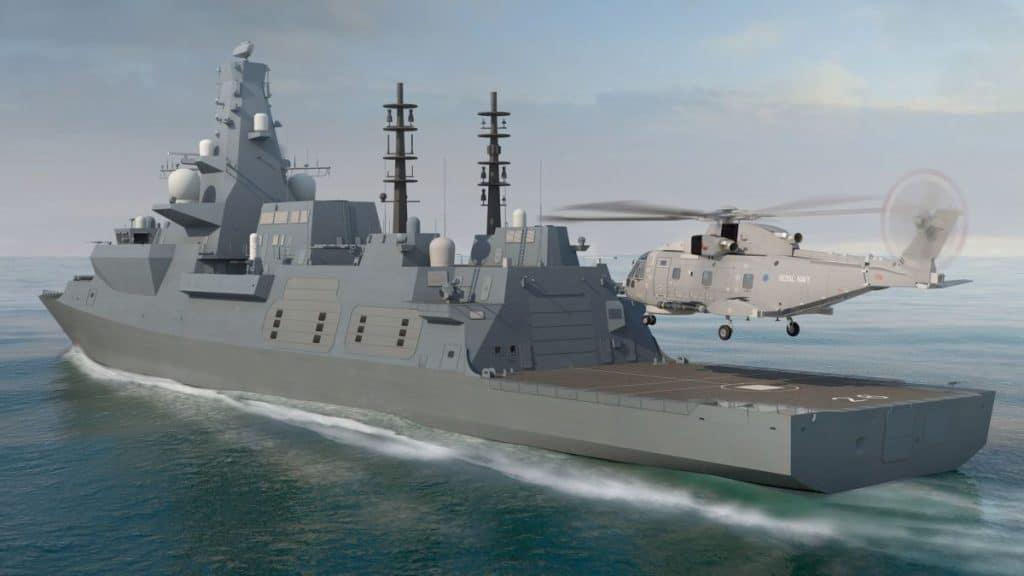On November 15, during the G20 summit of world leaders in Bali, Indonesia, British Prime Minister Rishi Sunak announced a new deal for five Class 26 Global Combat Ship frigates. The contract with BAE Systems was signed by the UK Ministry of Defence. Signing the document was a matter of time, as the government had earlier confirmed that funds had been allocated for this purpose.
All units, which will cost the British taxpayer £4.2 billion (around PLN 22.4 billion), will be built at the Govan and Scotstoun shipyards in Glasgow. In the former, the frigates will be constructed until launching. After leaving the dry dock, they will be moved to Scotstoun, where they will be equipped. Future frigates have already been named after British cities: Birmingham, Sheffield, Newcastle, Edinburgh and London. They will join already previously contracted: Glasgow, Cardiff and Belfast.
All works are to be completed by the mid-1930s. To date, the Royal Navy will take delivery of all eight frigates. The first of the newly ordered units is expected to enter service in 2028. The new contract fulfills the government’s long-term commitment to fielding a fleet of eight ships with anti-submarine capability.
“We are investing in our fleet to ensure our Royal Navy maintains a world-leading capability to protect Britain’s maritime interests,” Defense Secretary Ben Wallace said.
We have been awarded £4.2bn by the Ministry of Defense to manufacture the next five City Class Type 26 frigates for the @RoyalNavy, securing 4,000 UK jobs and work at our Glasgow facilities into the 2030s. @DefenceHQ https://t.co/vCrSBUtufL pic.twitter.com/yH2EPvZq89
— BAE Systems Maritime (@BAES_Maritime) November 15, 2022
According to the government statement, the contract with BAE Systems will secure 1,700 jobs over the decade, and together with the supply chain, this number will increase by another 2,300. In total, more than 120 sub-suppliers from Great Britain are involved in the construction of these ships. The first three frigates of this type were ordered in 2017. So far, none of them have been completed, but this year the first to leave dry dock: HMS Glasgow. Almost three years later, it will be delivered to the Royal Navy and undergo trials, after which – if carried out without problems – it will enter service in 2028. Already at the turn of 2022 and 2023, steel cutting is planned for the first of the ships of the second series: HMS Birmingham.
BAE Systems chief executive Charles Woodburn said the contract secures the future of the UK’s critical industry. He also talked about investments, including the planned construction of a shipyard hall in Govan. The company has applied to the local authority for planning permission to build a 175m long covered hall at a cost of more than £100m. The project will allow for the construction of two frigates at the same time.
I visited HMS Glasgow today with my drone today, again. Many of you will notice that much of the scaffolding on the Type 26 Frigate has been removed ahead of the vessel being moved onto a semi-submersible barge before being moved down river to be lowered into the Clyde. pic.twitter.com/G76fECqRZN
— George Allison (@geoallison) November 9, 2022
“This underpins ongoing investment in the skills, infrastructure and technology needed to remain at the forefront of the maritime sector and support the UK Government’s national shipbuilding strategy,” said Woodburn.
BAE representatives assure that if the hall is approved, a third ship from the first batch could be built inside it. In addition, the new investment is to be the main factor thanks to which the next five ships will cost proportionally less than the three of the first series. They are also supposed to be delivered much faster. Wallace recently announced that the construction of the first series of ships was overdue and over budget.
In a written statement to parliament on November 2, the defense secretary attributed the delay to the impact of the coronavirus pandemic, as well as design and supply chain issues. The delay will add £223m to the total cost of the programme.
This is what the frigate HMS Venturer type 31 is supposed to look like.
(Babcock)
– Due to the impact of the COVID-19 pandemic, which led to the closure of Govan Shipyard for several weeks, and the challenges typical of a first-of-its-kind vessel, including finalizing the design and timely delivery of key components, the ministry expects a 12-month delay in reaching initial operational capability , from the assumed October 2027 to October 2028, the secretary of defense informed.
All Type 26 frigates will be built by the middle of the fourth decade of this century. In service, they will replace the currently used eight type 23 frigates. Their task will be anti-submarine warfare and air defense. It will be complemented by lighter type 31 frigates. The keel for the first of them – HMS Venturer – was laid down on April 26 at the Babcock International shipyard in Rosyth. The launch is due next year. The construction of the second ship of this type, HMS Active, will start next year. They will be used for anti-terrorist activities and will fight smuggling in the Indian Ocean, as well as provide assistance in the event of natural disasters.
See also: Will twenty-five Growlers end up in the desert graveyard?
BAE Systems

